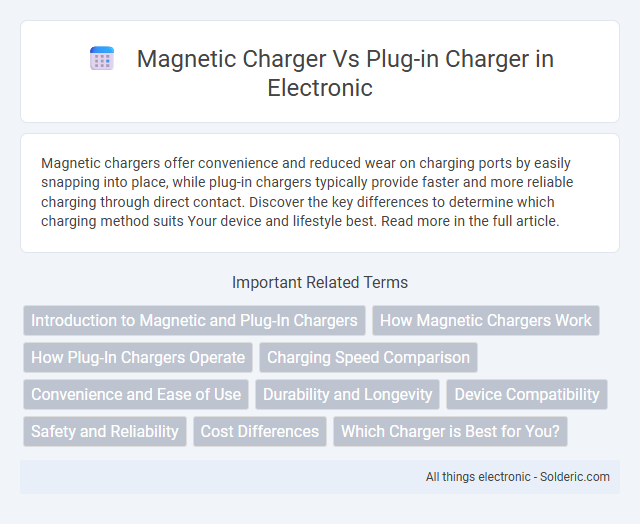Magnetic chargers offer convenience and reduced wear on charging ports by easily snapping into place, while plug-in chargers typically provide faster and more reliable charging through direct contact. Discover the key differences to determine which charging method suits Your device and lifestyle best. Read more in the full article.
Comparison Table
| Feature | Magnetic Charger | Plug-in Charger |
|---|---|---|
| Connection Type | Magnetic attachment, easy snap-on | Physical plug insertion |
| Durability | Reduced wear on ports, less mechanical strain | Frequent plug/unplug wear, port damage risk |
| Charging Speed | Moderate to fast, depends on magnetic contact quality | Generally faster, stable direct connection |
| Ease of Use | Quick attach/detach, user-friendly | Requires precise alignment and insertion |
| Compatibility | Limited to devices with magnetic charging ports | Compatible with a wider range of devices |
| Safety | Disconnects easily to prevent damage from tugging | Risk of port damage if pulled harshly |
| Portability | Compact, fewer broken connectors | Standard cables, potential wear on connectors |
Introduction to Magnetic and Plug-In Chargers
Magnetic chargers utilize a magnetic connection to easily align and attach the charging cable to your device, reducing wear and improving convenience. Plug-in chargers require physically inserting a connector into the device's port, offering a secure connection but risking port damage over time. Choosing between magnetic and plug-in chargers depends on your preference for ease of use and device durability.
How Magnetic Chargers Work
Magnetic chargers use a magnetic connection to align the charger and device, ensuring efficient power transfer without physical plugs. The charger's magnetic pins match the device's contacts, enabling a secure and quick attachment that reduces wear on ports. Your device charges effortlessly as the magnetic field maintains consistent electrical contact, providing a convenient and reliable alternative to traditional plug-in chargers.
How Plug-In Chargers Operate
Plug-in chargers operate by connecting directly to an electrical outlet, delivering a steady flow of electricity through metal prongs that fit into the socket. These chargers maintain a consistent connection, allowing efficient power transfer to your device's battery without interference. Your device begins charging immediately once the plug is securely inserted, ensuring a reliable energy source.
Charging Speed Comparison
Magnetic chargers typically offer slower charging speeds compared to plug-in chargers due to weaker electrical contact and limited power transfer efficiency. Plug-in chargers deliver direct current flow with minimal resistance, enabling faster and more consistent charging rates, especially for high-capacity batteries. Devices designed for rapid charging often prioritize plug-in connections to maximize wattage and reduce overall charging time.
Convenience and Ease of Use
Magnetic chargers offer superior convenience by seamlessly attaching to devices without precise alignment, reducing wear on charging ports and enabling effortless one-handed operation. Plug-in chargers require careful insertion into charging ports, which can be less practical in low-light or fast-paced situations. The magnetic connection also allows for quick detachment, minimizing the risk of device drops and enhancing overall ease of use.
Durability and Longevity
Magnetic chargers typically offer enhanced durability due to their reduced wear and tear on both the cable and device port, as they disconnect easily when pulled, preventing damage. Plug-in chargers, while generally reliable, often experience cable fraying and port wear from repeated plugging and unplugging, which can shorten their lifespan. Your choice influences charging longevity, as magnetic chargers tend to maintain device port integrity longer, extending overall usability.
Device Compatibility
Magnetic chargers offer enhanced device compatibility by easily connecting to various devices with a magnetic port, reducing wear and tear on charging ports compared to traditional plug-in chargers. Your devices equipped with standardized magnetic connectors, such as certain smartphones and earbuds, benefit from quick attachment and detachment without affecting the device's physical connectors. In contrast, plug-in chargers require precise alignment and physical insertion, which limits compatibility across different models and increases the risk of port damage over time.
Safety and Reliability
Magnetic chargers offer enhanced safety by reducing the risk of accidental cable damage and electrical shock through their quick-release mechanism, which prevents pull-related hazards. Plug-in chargers provide reliable, stable connections but carry a higher risk of wear and tear on both the charging port and cable, potentially leading to short circuits or connection failures over time. The magnetic design minimizes physical strain on devices, making it a safer choice for long-term reliability in everyday charging scenarios.
Cost Differences
Magnetic chargers typically cost more upfront due to advanced technology and convenience features compared to traditional plug-in chargers, which are generally cheaper and widely available. Maintenance costs for magnetic chargers may be lower since they reduce wear and tear on device ports, potentially decreasing repair expenses over time. However, plug-in chargers are often more affordable to replace if damaged, making them a budget-friendly option for many users.
Which Charger is Best for You?
Magnetic chargers offer convenience and reduced wear on charging ports by easily snapping into place without precise alignment, making them ideal for frequent, on-the-go use. Plug-in chargers provide a stable and often faster charging connection, suitable for situations where consistent power delivery is a priority. Your choice depends on whether you prioritize ease and durability with magnetic charging or speed and reliability with plug-in options.
Magnetic charger vs plug-in charger Infographic

 solderic.com
solderic.com